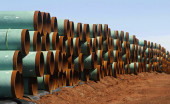Re Ian Bremmer 'Could third-party candidates upend the 2024 US election?' 3 April The current political movement in the USA…
Alberta 2016
Written by Diana Thebaud Nicholson // May 17, 2016 // Canada, Natural Disasters, Oil & gas // Comments Off on Alberta 2016
Notley’s first year: Calm in crisis, strong in delivery
Gary Mason
 The collapse in oil prices has brought the province to its knees, and yet, amid all the anxiety and legitimate fright the situation has incited, the Premier has been a picture of calm and strength.
The collapse in oil prices has brought the province to its knees, and yet, amid all the anxiety and legitimate fright the situation has incited, the Premier has been a picture of calm and strength.
And now she has to deal with one of the greatest natural disasters the country has ever seen, the devastating Fort McMurray wildfire.
(Globe & Mail) … imagine you are replacing a dynasty that has ruled the province for decades, one that has for generations fed the political ecosystem that is the foundation of any government, one comprising officials and appointees of all manner of description, responsible for roles big and small in the overarching governance of a province.
And you need to find people, hundreds if not thousands of them, to replenish this ecology with those of your own ideological bent.
That alone is enough to make you ponder with some admiration the enormous task Rachel Notley confronted when she took over as Alberta Premier a year plus a day ago.
Then throw in the ambitious social and economic agenda she has launched amid a crushing blow to Alberta’s economy, and more recently the devastating natural disaster that has befallen one of the province’s most important towns, and her situation is more impressive still. High praise for Premier Notley as CBC’s Insiders debate The Politics of Disaster Management
The Alberta wildfires moved toward major oil-sands facilities. Both Suncor Energy and Syncrude Canada evacuated workers from camps outside of Fort McMurray after the massive fires suddenly shifted north. Some 4,000 workers were relocated.
13 May
Justin Trudeau tours wildfire-ravaged Fort McMurray, meets slayers of ‘the beast’
(CBC) PM announces laid-off workers in Edmonton will qualify for extended EI in July
CTV Video: Trudeau and Notley hold news briefing after Fort McMurray tour – Prime Minister Justin Trudeau says he doesn’t think Canadians understand yet the scope of what happened in Fort McMurray where 2,400 buildings were destroyed by a wildfire last week. He said despite following updates and watching images on TV, the scale and the disaster didn’t hit him until today.
Surveying Fire-Ravaged Fort McMurray, Justin Trudeau Praises Responders
(NYT) After taking a helicopter tour of fire-ravaged Fort McMurray, Alberta, on Friday, Prime Minister Justin Trudeau credited firefighters for saving much of the city.
An official count found that 2,432 buildings were destroyed and 500 were damaged. About 25,000 buildings are “still standing” but may have smoke damage.
“I don’t think Canadians yet understand what happened here,” Mr. Trudeau told firefighters and rescue workers after touring the city. “They know there was a fire. They’re beginning to hear the wonderful news that so much of the town was safe. They don’t yet understand that this wasn’t a fluke of wind or rain or luck, that this was the extraordinary response by people such as yourselves — the work you did to save so much of this community.”
12 May
Fort McMurray Fire: Suncor Pilot Broke Rules To Fly Pets To Safety
Call him Noah.
(HuffPost) Suncor’s airline Sunjet worked with partners Air Canada, Air North, Enerjet, North Cariboo, Sunwest, Westjet, and West Wind to get pets and their owners out of Fort McMurray. Crews welcomed the pets — including dogs, rabbits, cats, chinchillas, hedgehogs and a frog — into the planes’ cabins.
Mann said there was a rumour someone brought along their pet pig.
10 May
Oil industry aims for speedy return to business-as-usual, in wake of Fort McMurray wildfires
(Edmonton Journal) Oilsands facilities north of Fort McMurray could be back up and running in the next few days, and more will return to production in the next few weeks, Premier Rachel Notley said Tuesday.
“This wildfire is raging in the heart of Alberta’s oilsands region, so while everyone’s focus from the beginning has been on protecting the safety of our citizens, there are real and immediate impacts to the livelihood of thousands and, of course, to our economy,” she said at a news conference.
9 May
Cooler Weather Helps With Alberta Wildfire as Premier Visits
(Bloomberg) Firefighters kept blaze from damaging Suncor operations — Company begins planning production restart as fire moves east
Cooler temperatures are helping fire fighters … as the blaze retreats from the country’s main oil-sands facilities around Fort McMurray. … after the fires knocked out an estimated 1 million barrels of daily production.
7 May
A week in Hell: How Fort McMurray burned
At first, wildfire MWF-009 burning to the southwest of Fort McMurray seemed like many others that residents had experienced – smoke and haze, but no real danger. That all changed in a flash, Jana G. Pruden reports, as the winds shifted, prompting a mass evacuation, panic and devastation
Latest Fort McMurray updates: Fire could double in size
What are governments and Canadians doing?
Help from Ottawa: air assets, 7,000 cots for evacuees in emergency shelters and another 13,000 on the way; and a federal government commitment to match individual donations.
Help from Alberta: debit cards to assist evacuees with food and shelter; adults will receive $1,250 each and dependents will get $500. Total cost to the province: $100-million.
Help from B.C.: government has ruled out sending firefighters to Alberta because of ongoing wildfires in B.C., but announced several aid measures on Saturday, including include 30 health-care personnel; mobile medical unit is ready to head to Alberta if needed and Emergency Management BC, the provincial response agency, is ready to offer emergency evacuation staff and experts in emergency social services.
As of Friday, $30-million had been pledged to the Red Cross, including a $300,000 B.C. government donation.
Work camp housing wildfire 1st responders forced to evacuate
Inside the city, police are going house to house, looking for people who may have been unable to leave
A massive wildfire nicknamed “the beast” has forced a work camp north of Fort McMurray housing first responders to evacuate Saturday night.
Non-essential staff are currently being sent south of Fort McMurray to safe sites on buses. Some workers will be sent to Grey Wolf, another camp north of Fort McMurray. …
All oilsands facilities in the area are surrounded by wide firebreaks and are protected by their own highly trained fire crews, Morrison said. Syncrude, which is further north, is also shutting down its operations in the area

6 May
Rex Murphy | Fort McMurray Wildfire
Rex Murphy says Albertans define the meaning of true neighbour: When people are hurting, all are welcome
3 reasons why the Martin Mars water bomber isn’t battling fire in Fort McMurray
The 70-year-old plane was retired from service in 2013 because of limited capabilities
The province ended its contract with the Coulson Group in 2013 to use the air tanker, opting to move to smaller aircraft more suitable to B.C.’s mountainous terrain, although it was used for one month in 2015 to fight wildfires in B.C.
The massive air tanker was built as a transport plane for the U.S. Navy in 1946 and is the largest fixed-wing water bomber in the world, with a capacity of more than 27,000 litres. But due to its size, the Martin Mars can only land on and scoop up water from about 113 water bodies in B.C., as opposed to the 1,700 water bodies that other smaller amphibious scoopers can access.
It also can’t drop flame retardant, and fire crews often have to stop work on fires because of the large drop pattern, according to the Forest Ministry’s website.
5 May
The ‘Extreme’ Wildfires in Fort McMurray
The government in Alberta said Thursday a total 49 wildfires are burning in and around the Canadian city.
(The Atlantic) A small blaze began in Fort McMurray, located in Canada’s oil-sands country, over the weekend. Dry conditions and a sudden spike in temperature to 32 degrees Celsius, or about 90 degrees Fahrenheit, fed the flames, which by Tuesday had become too severe to control. The Regional Municipality of Wood Buffalo, where Fort McMurray is located, ordered a mandatory evacuation of the city Tuesday night. About 88,000 people have evacuated Fort McMurray since.
Fort McMurray Fire Was Likely Caused By Humans: Researcher
(Canadian Press via HuffPost) 50 per cent of fires caused by people
An average of 1,200 wildfires are reported in Alberta each year, and half of those fires are caused by humans, according to the National Fire Database. Lightning is the second-leading cause with 47 per cent.
4 May
When Helping Hurts: Why You Shouldn’t Donate Physical Goods During A Disaster
I have been fortunate to be able to assist on the ground with disaster relief in communities across Alberta including the Slave Lake fire in 2011 and the Calgary floods in 2013, and I’ve learned that cash donations, even small ones, are by far the most effective way to help those recovering from a disaster.
Our compassion tells us we need to help these people get back on their feet, replace the things they’ve lost. So we start collecting food, clothing and household items for them. We don’t realize that it could be 2 years before they have a place to put them. We don’t realize that someone will have to sort, warehouse and distribute what we collect. We don’t realize that for heath and safety reasons a lot of what we collect cannot be distributed. Often leading to our own heartbreak when our hard work is turned away. In these first few weeks emergency shelters are equipped to provide the necessities of life: food, clothing, and shelter. Regardless of whether you are staying in a shelter or not, you can go there to gain access to these basic services.
An example of unforeseen need is that during a wildfire, electricity to the community is lost. This means that even if a home was not affected by the fire, every single fridge and freezer will need to be replaced. We are talking tens of thousands of appliances. This is not something that can be donated, shipped, sorted, and tested. It takes extreme buying power, manufacture negotiations and logistical coordination at a global scale. This is why organizations like the Red Cross in cooperation with government , are powerful tools in times of disaster.
Quebec sends water bombers to Fort McMurray
(CTV) Because all flights to Fort McMurray are grounded, the water bombers have to land about 300 kilometres away.
They will scoop up water from lakes, and dump it on the inferno.
Lead now: Have you seen the news? At 6:20pm yesterday, a mandatory evacuation order was issued for the entire city of Fort McMurray because of a massive wildfire fuelled by high temperatures and tinder-dry forest. This is the largest fire evacuation in Alberta’s history and it’s expected to get worse today when winds are forecast to switch direction and become even more intense, increasing damage and hindering the efforts of emergency crews.[1]
We know many people are wondering how they can help. The Red Cross has set up an emergency ‘Alberta Fires’ appeal and you can click here to donate. You can also text REDCROSS to 30333 to make a $5 donation.
In Alberta? The situation is changing quickly. Here’s where you can get up-to-date information through twitter, facebook, the government of Alberta’s emergency alert app, as well as numbers to call for assistance and how to report that you are safe.
Amara Possian, on behalf of the Leadnow team
3 May
We know that things don’t look too great at the moment.
The economy is tanking and the provincial government is plunging further and further into deficit.
Sure, there are some optimists who see a “flicker of hope” in rising oil prices. But even they admit that most oil producers can’t generate a profit at current levels.
Downtown Calgary is starting to look like a ghost town – Commercial real estate vacancies are up 20 per cent and experts say it’s only going to get worse. By 2018 the downtown core could have 11 million square feet of empty offices.
The oilsands are set to lose even more jobs And if you’re a construction worker in the oilsands, you might want to think about switching industries. Construction jobs in the oilsands are expected to virtually disappear in the next four years.
Wages are plummeting – weekly wages have fallen faster in Alberta this year than in any other province, dropping 3.4 per cent to $1,118.
Massive fires. And no money for firefighters.Wildfire season has started and according to one expert the province is just “waiting to burn.” Hot, dry weather has created ideal conditions for forest fires … the Alberta government [has] cut almost $15 million from the province’s wildfire budget.
8 April
Alberta budget: Starring a social worker, an oil crisis and missing billions
As Alberta’s economy muddles through a second consecutive year of recession, Finance Minister Joe Ceci won’t have much extra money to deliver on Premier Rachel Notley’s promise of creating a fairer province in next week’s budget.
Many details about the first full budget from Alberta’s New Democrats have been released ahead of its unveiling next Thursday. The deficit is expected to be $10.4-billion – not a record but the largest in a generation – and the government has reneged on a promise to return the budget to balance by the end of the decade.
The cause of the province’s fiscal challenge is persistently low energy prices – as well as expensive government services that can’t be paid for solely by Alberta’s low personal and corporate tax rates. With the price of oil languishing below $40 (U.S) a barrel, billions of dollars in annual revenue are missing from the province’s treasury. The royalties from oil and gas that once paid for one-fifth of the province’s services have all but disappeared. While Albertans are used to their province’s economic roller coaster, one that plunges with deep layoffs and climbs with employment surges, this downturn is more pronounced and long lasting than those seen in the past two decades. “There is no question that this is a very serious and prolonged shock, the most dramatic in generations,” Ms. Notley said during a televised address on Thursday.
6 January
The death of the Alberta dream
Large-scale layoffs, empty office towers, falling house prices: Alberta has been gutted by the glut.
(Maclean’s) … the upheaval many Albertans, new and old, have suffered since oil prices began their long, hard crash. It’s affected everyone from steel-toed rig hands to French-cuffed executives, with layoffs hitting Calgary and Fort Mac, not to mention the many small towns across Alberta that rely heavily on the energy sector.
As this downturn has unfolded, the great oil rout of 2014-15 seemed, at least at first, to be following a similar pattern to other busts. Some big oil sands projects get delayed, rig and well activity shrivels and Employment Insurance rolls spike, leading to knock-on effects: Calgary towers thin out, the real estate market softens, and cuts spread to everything from shops to restaurants. Yet past plunges were reliably followed by a bungee-like snap back in growth, as oil prices regained their upward momentum. It’s a pattern a generation of Albertans has come to expect, after the 1998 Asian financial crisis, the 9/11 terrorism shock and the 2008 financial crisis.
But the broad optimism of early 2015 has gradually given way to dread. This feels more like the awful 1980s, with no swift recovery to come—not in a world glutted by oil, as Saudi Arabia battles to squeeze out higher-cost producers like Russia and the United States.


